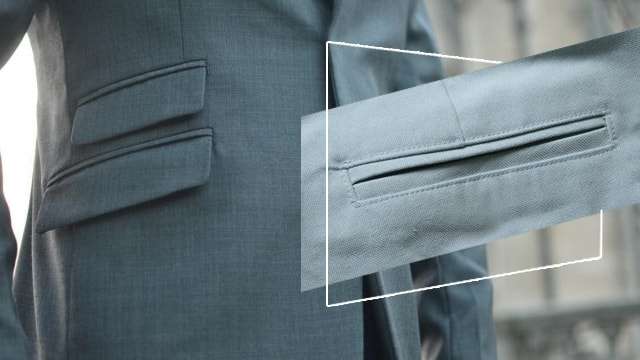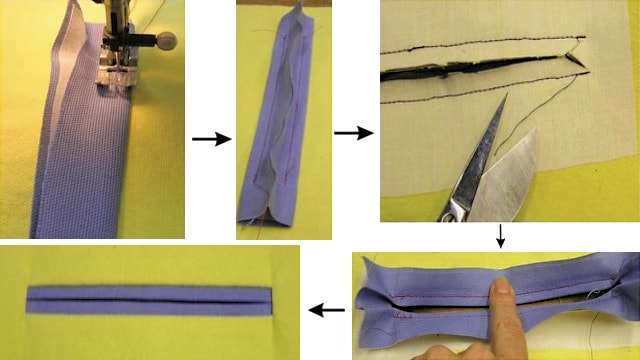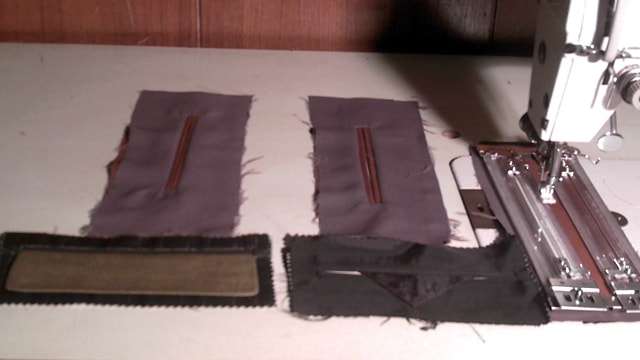
The making of a Piped Pocket (also called double bone pocket) is very crucial in all types of garments as there is a requirement of a consistent width of bones & parallel and neat appearance at the ends, which is not always easy. While using stripes or checks, matching is yet another concern. Manual operation is always time consuming as a lot of handling, slashing and turning of fabric is involved.
Priya Kumar, BF Tech from NIFT, New Delhi and Professor Prabir Jana, Chairperson, Dept. of Fashion Technology, NIFT analyse the operation of Piped (Welt) pocket and the technology involved at the basic and highest levels.
Basic Level of Technology (Manual Operations)
This level is the most rudimentary level of the welt pocket making operation where simple lock stitch machines are used for the process. It requires dexterity and skilled labour to complete this operation at this level. Strict control over the machine is necessary to make the pocket as per defined quality standards. After the pocket position is marked, the bone fabric is placed as shown in the picture and two parallel rows of stitches are made in two operations using a single needle lockstitch machine. Auto back tack and number of stitches can be programmed to ensure both stitch lines are equal in length, but the parallelism of stitches depends on operator skill. After slashing between stitch lines and mitering of corners, the bones are turned; inside corners are tacked using a single needle lockstitch machine. As the operator slashes using a pair of scissors, there is a possibility of inconsistency between pieces and also damage.
|
|
|
Makes and Models |
Features and Specification of Machinery and Equipment |
|
JUKI – 5550N series, |
Max. sewing speed 4,000 to 5,000 spm |
|
Max. Stitch Length 4 to 5 mm |
|
Needle bar stroke: 29 to 35 mm |
|
Lift of presser foot: 5 to 13 mm |
|
Machine should be equipped with needle positioner, underbed trimmer (UBT), auto back tack, and a programme for number of stitches. |
Machinery and Equipment Required for Basic Level of Technology
Flat bed single needle programmable lockstitch machine with drop feed, Scissor
Intermediate Level of Technology
The intermediate level uses double needle lockstitch machine with or without centre knife cutter. Two parallel lines are stitched in one operation thus avoiding distortion. If the machine is equipped with a centre knife cutter, then slashing is done simultaneously with the stitching and the operator has to only mitre the corners and turn inside. Another option is using a specialised folder with singe needle lockstitch machine. This option can yield 100 pockets per hour. The attachment allows a single needle lockstitch machine to perform pocket welt sewing in any width and length easily and accurately. pocket welting width (4 to 50 mm) and length (maximum 160 mm) freely adjustable and various kinds of pocket mouths can performed through cloth setting (single welt, double welt, pocket with flap) irrespective of the thickness of the fabric. a special presser foot advances engaging with the rail and sewing ends at the stopper. therefore even width and dimensions are obtainable by anyone”.

|
|
|
Makes and Models |
Features and Specification of Machinery and Equipment |
|
Duerkopp Adler 238N series (now discontinued) |
2-needle lockstitch machine with needle feed vertical trimmer between the needles, thread cutter, presser foot lifting, bartacking automatic, for sewing piped pockets |
|
JUKI – 5550N series, Duerkopp Adler 251-140042, Sunstar KM-235 series |
Max. sewing speed 4000 to 5000 spm |
|
Max. Stitch Length 4 mm to 5 mm |
|
Needle bar stroke: 29mm to 35 mm |
|
Lift of presser foot: 5 to 13 mm |
|
Machine should be equipped with needle positioner, underbed trimmer (UBT), auto back tack, and programme for number of stitches. |
|
Welt pocket folder for single or double bone pocket. |
|
Jasi Corp. Japan; Entire Clothing, India |
Welt attachment for single needle lockstitch machineWelt width- 4mm to 50 mmWelt Length – 160 mm |
Machinery and Equipment Required for Intermediate Level of Technology
Flat bed single needle programmable lockstitch machine with drop feed, Scissor
Highest Level of Technology
The highest level of technology features automatic, versatile, flexible and highly productive pocket welting machines. These machines have different variants for straight welts and slanted welts and can be customised with a wide range of optional accessories for use in various types of pocket welting applications. Cycle sewing in these machines allows the sewing of different types of welts in alternating combinations.
These efficient machines have a speed ranging from 2,500-3,000rpm and production ranging between 1,200-2,800 pocket welts per shift 8 hours, while welt lengths ranging between 20 mm – 230 mm can be stitched. The machine incorporates the work of about 8-10 machines with a worker on each. Also, the machine requires one worker only, who may not be specifically skilled in the intricate pocket welting operation, but needs to be aware of how to operate the machine.

All models in this category have Active Marking Lights (Laser Lights) for easy placement of the fabric panel. These eliminate the need for manual marking on both trouser and jacket welting operations. These machines are generally lubricated using oil and have a wick lubrication mechanism which keeps the machine parts well oiled, minimising frictional wear and tear that related to its high speed operation.
To ensure high quality corner cutting on all kinds of fabric, machines have stationary tab knives combined with the AC servo motor controlled carriage movement and it automatically cuts a slit or notch in the welt material which reduces and distributes the thickness evenly in the finished welt ends.
The machines also ensure Automatic Flap Sewing, on left or right welts. Moreover, Independent clamping can be activated if the operator prefers to spread the fabric before the sewing operation.
Some machines may also have an automatic interlining feeder which automatically feeds rolled interlining onto the table and cuts it. It helps reduce the time required to place the interlining, thereby increasing productivity and workability.
These machines have a vertical hook set, which eases and facilitates the changing of bobbins. These may use normal or large bobbins and a bobbin needs to be changed after roughly 200 welts.
A Vacuum System, which is incorporated in almost all stations in this segment, is recommended to be used for sewing welts into the back panels of trousers which have a dart seam. The system can be used with its own independent vacuum motor or hooked up to the existing plant vacuum system. Some machines also have a blower option to sew light weight fabrics and Lycra. Others also have a dart stretcher which holds the end of the material when making a welt on the darted part of the material to make it easier to set the darted part and improve the reliability of the welting.
The machines have an Under Bed Trimmer (UBT) and Thread Breakage Detector, which stops the machine in case of thread breakage.
Most machines have a graphic touch screen, hence the operator is provided with a user- friendly working environment and with icons for every operation required to sew the perfect pocket welt.
Value for Money
Higher technology levels generally ensure a dual benefit in terms of quality consistency and better productivity. The Return on Investment of different equipment differs, based on the scale of operations, the extent of use of the machine and the types of merchandise produced. While a workstation can make 2000-2400 pocket welts, while comparing similar operation one operator can produce only 200-240 pocket welts per shift at the basic level. Even though the intermediate level single needle lockstitch machine using a specialised attachment can produce up to 800 pockets per shift, this option is not very popular due to non availability of the attachment and the centre knife machine being being discontinued by major brands. ROI for the highest level of technology can be calculated, though not totally exact.
ROI for Automatic Welt Pocket Making Machine
Even though ROI is generally calculated for the whole range of machinery (required for a garment) rather an isolated piece of equipment here we will calculate ROI for a single machine for this specific operation to serve as an example.
To calculate ROI, we need to first calculate the Depreciated Value of the machine. The machine will keep reducing in cost over the years, increasing the ROI. For this example, we will leave out the inflation factor, to simplify understanding.
Only one operator will be employed, at a salary of Rs 3,500 pm [Rs 42,000 pa].
|
Machinery and Equipment Required Automatic pocket welting workstation |
|
Makes and Models |
Features and Specification of Machinery and Equipment |
|
Juki APW-895, |
Double needle 301 type lockstitch |
|
Sewing speed – 1500 to 3500 SPM |
|
Start and End speed – programmable |
|
Back tacking – 2 to 15 mm |
|
Changeable between condensation and back tacking |
|
Programmable start and end speed |
|
Welt style – parallel single or double, with or without flap |
|
Needle gauge – 10 mm to 24 mm |
|
DC motor controlled feed system |
|
Automatic needle thread indicator and bobbin thread monitoring device |
|
Slanted for trousers, quick folder changeover |
Machinery and Equipment Required Automatic pocket welting workstation
Manually Operated Machine
A look at the manually operated machine with one operator has the following industrial averages:
1. Cost of machine: Rs 30,000
2. Output: 240 pockets a day, or 240 x 26 x 12= 74,880 pockets pa
3. CM Cost output pa=Rs 74,880 x 0.30 = Rs 22,460 pa per machine
4. Salary Rs 3,000 pm or Rs 36,000 pa
5. Rate of Depreciation = 12%
The number of operators required to match the output of the fully automatic machine using one operator works out to be 9. With 9 operators, absenteeism and turnover cannot be ruled out totally. Capital outlay = Rs 30,000 x 9= 2,70,000, to which, at best, 9 salaries have to be added, i.e., Rs 36,000 x 9=3,24,000, totalling almost 6 lakhs. But the income from the 9 machines works out to only 22,460 x 9=2,02,140, nowhere near the other machine’s figures. It is obvious that, in this scenario, the only way out is a capital intensive one-time buy of a fully automatic machine that requires only one worker.
ROI calculation
Depreciated Value = NBV/{1+DR/100} and Depreciation= NBV- NBV/{1+DR/100} Where NBV=Net Book Value[Current Cost], DR= Rate of Depreciation, n= No. of Years Rate of Depreciation =12% In the current case, Cost of new machine: $18,500 (approx) or Rs 9 lakh (approx) Using the above formula, Depreciated Value works out to be Rs 900000/[1+12/100]¹ =900000/1.12=803571.43 or Rs 8,03,570 after one year Depreciation=9,00,000-8,03,570=Rs 96,430 Parameters Assumed Operator salary = Rs 3,500 pm or Rs 42,000 pa CM Price per pocket = Rs 0.30 ROI for any year = CM Price from one machine less operator salary till that year / Depreciated value of that machine, expressed as a percentage. – No of pockets per day=2,000 • Yearly production=2,000 x 26 x 12=6,24,000 • CM Price per pocket=Rs 0.30 • Yearly CM Price = Rs 1,87,200 less 42,000 salary=1,45,200 which remains constant ROI Year 1= 145200/803570=18.1% Since NBV will keep reducing while the denominator stays constant, ROI will keep increasing. Let us see what happens after 4 years: Formula : Depreciated Value[Dv] = NBV/{1+DR/100} Dv=9,00,000/[1+12/100]4=900000/1.5735 = Rs 5,71,966 ROI=145200 x 4 / 571966 = 580800/571966 = 101.5% Thus the machine pays for itself at approx 3 years 11 months; only profits will accrue thereafter.

Post a Comment